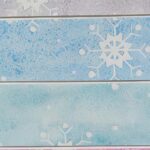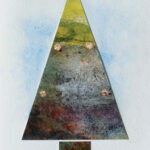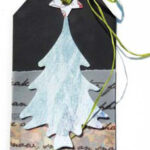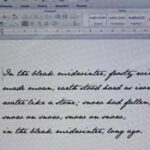
Creating your own greetings cards is a wonderful way of putting all your skills into practice, using materials you may already have and testing out new techniques. Here are some ideas I have discovered over the years
 Even the simplest of designs can look impressive with the use of more than one layer. Think of your design exactly as you would a painting but in miniature; it still needs a background, middle ground and foreground to bring the subject to life.
Even the simplest of designs can look impressive with the use of more than one layer. Think of your design exactly as you would a painting but in miniature; it still needs a background, middle ground and foreground to bring the subject to life.
Technique: In my card designs, as in my work, I use plenty of collage and Watercolour Ground. I use Pebeo Bindex to apply the collage, both in a thin layer under the paper and on top to sandwich it down. This helps to prevent layers from buckling and gives a smooth finish. I also add a little watercolour ground on top to help it accept paint or colour afterwards.
In my card designs, as in my work, I use plenty of collage and Watercolour Ground. I use Pebeo Bindex to apply the collage, both in a thin layer under the paper and on top to sandwich it down. This helps to prevent layers from buckling and gives a smooth finish. I also add a little watercolour ground on top to help it accept paint or colour afterwards.
Top Tip: Bindex is the perfect consistency – there is no need to thin it down but do use an old brush!
 Tracing paper is the perfect tool for experimenting with composition and Tracedown is usually the fastest way to get it onto your surface.
Tracing paper is the perfect tool for experimenting with composition and Tracedown is usually the fastest way to get it onto your surface.
Technique:  Use tracing paper for a repeating pattern, draw it out once, determine the size of your design area and then use the tracing paper to copy it into a pleasing layout. This way if you want to alter any of your composition before you start, you can change it straight away without the risk of damaging your surface.
Use tracing paper for a repeating pattern, draw it out once, determine the size of your design area and then use the tracing paper to copy it into a pleasing layout. This way if you want to alter any of your composition before you start, you can change it straight away without the risk of damaging your surface.
 I am a huge fan of collage. It is a lovely way of incorporating different textures into my work and uses up the papers that I have ‘kept for a special project’ that lurk in a box under my desk! Discarded paintings can be used as ‘collage papers’.
I am a huge fan of collage. It is a lovely way of incorporating different textures into my work and uses up the papers that I have ‘kept for a special project’ that lurk in a box under my desk! Discarded paintings can be used as ‘collage papers’.
Technique: Tearing papers rather than cutting them, not only produces a lovely random effect but also helps to accept any colour that you may want to bleed into the edges. Use a watercolour ground over the top to push the collage papers back into the surface so they don’t look like they are floating in mid air.
Tearing papers rather than cutting them, not only produces a lovely random effect but also helps to accept any colour that you may want to bleed into the edges. Use a watercolour ground over the top to push the collage papers back into the surface so they don’t look like they are floating in mid air.
Top Tip: Use a palette knife to apply the ground by coating the back of the blade and dragging it over the surface with a light pressure. If you are also working straight onto a watercolour card, it helps the collage look like the surface when applied this way.
Use a palette knife to apply the ground by coating the back of the blade and dragging it over the surface with a light pressure. If you are also working straight onto a watercolour card, it helps the collage look like the surface when applied this way.
I use words a great deal in my work and am often inspired by the images they conjure up in my head and what better time to incorporate words than Christmas? Use a computer (or for technophobes a typewriter) to transfer the song or hymn of your choice onto paper for use in collage.
Technique:  If I am using a computer, I like to play around with fonts that look like handwriting.
If I am using a computer, I like to play around with fonts that look like handwriting.
Top Tip: To avoid issues with copyright there are lots of websites that detail Christmas songs that are now in the public domain, or make up your own special words. In this article I used ‘In the Bleak Midwinter’, a carol based on a poem by Christina Rosetti.
To avoid issues with copyright there are lots of websites that detail Christmas songs that are now in the public domain, or make up your own special words. In this article I used ‘In the Bleak Midwinter’, a carol based on a poem by Christina Rosetti.
We all know that a painting we are not sure about can look totally different with a beautiful, clean mount around it and your greetings cards should be no different. One of my favourite ways of presenting a card is to treat it like a mini painting with a Premium Mount Kit that gives you all you need to present your masterpiece.
Technique:
Use quality tools for your cutting and mounting, a good steel ruler and a craft knife with a new blade. I also use a cutting mat at all times as it self heals and has a resistance when cutting into it which means that the knife is less likely to slip.
Top Tip:
Have you made a batch of cards and want to raise a few funds for the festive season? Pop your card plus its envelope into a presentation bag that seals at the top, add a sticker with your name and any contact details on the back and you will have a stock for your family and friends to purchase. There is, of course, the option to have your design printed rather than create multiples. When you have created your painting, photograph it from above in natural daylight, crop it neatly using a computer program and you can then either print it yourself or upload it to a printing website.